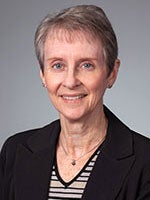Terry E. Jones, PhD

Associate Professor
252-744-6249
joneste@ecu.edu
Mailing Address:
College of Allied Health Sciences
Health Sciences Building, 3400
Greenville, NC 27834
Professional Interest
My research interests are in skeletal muscle’s response to exercise, obesity, weight loss surgery, and clinical conditions encountered by physical therapists.
The laboratory is also involved in research to understand the development of neuropathic pain following spinal cord injury.
Education History
- Ph.D. Biochemistry, University of Kansas, 2000
- M.S.Ed. Exercise Physiology, University of Kansas, 1988
- B.A. Physical Education (concentration – Exercise Science), Washburn University, 1985
Selected Publications
Zou K, Hinkley JM, Park S, Zheng D, Jones TE, Pories WJ, Hornby PJ, Lenhard J, Dohm GL, Houmard JA (2018) Altered tricarboxylic acid cycle flux in primary myotubes from severely obese humans. Int J Obes, https://doi.org/10.1038/s41366-018-0137-7
Haskins M, Jones TE, Lu Q, Bareiss SK (2016) Early alterations in blood and brain RANTES and MCP-1 expression and the effect of exercise frequency in the 3XTg-AD mouse model of Alzheimer’s disease. Neurosci Lett, 610:165-170
Jones TE, Stephenson KW, King JG, Knight KR, Marshall TR and Scott WB (2009) Sarcopenia – mechanisms and treatments. J Geriatr Phys Ther, 32:39-45
Jones TE, Basillo J, Brophy P, McCammon M and Hickner RC (2009) Long-term exercise training in overweight adolescents improves plasma peptide YY and resistin. Obesity 17:1189-1195
Boschek CB, Jones TE, Smallwood HS, Squier TC, Bigelow DJ. (2008) Loss of the calmodulin-dependent inhibition of the RyR1 calcium release channel upon oxidation of methionines in calmodulin. Biochemistry 47:131-142
Boschek CB, Jones TE, Squier TC, Bigelow DJ. (2007) Calcium occupancy of N-terminal sites within calmodulin induces inhibition of the ryanodine receptor calcium release channel. Biochemistry 46:10621-10628
Wright DC, Geiger PC, Han DH, Jones TE, Holloszy JO (2007) Calcium induces increases in peroxisome proliferator-activated receptor γ coactivator-1α and mitochondrial biogenesis by a pathway leading to p38 mitogen-activated protein kinase activation. J Biol Chem 282:18793-18799.
Wright DC, Han DH, Garcia-Roves PM, Geiger PC, Jones TE, Holloszy JO (2007) Exercise-induced mitochondrial biogenesis begins before the increase in muscle PGC-1α expression. J Biol Chem 282:194-199
Garcia-Roves PM, Jones TE, Otan K, Han DH, Holloszy JO, (2005) Calcineurin does not mediate exercise-induced increase in muscle GLUT4. Diabetes 54:624-628
Garcia-Roves PM, Han DH, Song Z, Jones TE, Hucker KA, Holloszy JO (2003) Prevention of glycogen supercompensation prolongs the increase in muscle GLUT4 after exercise. Am J Physiol Endocrinol Metab 285:E729-736
Baar K, Song Z, Semenkovich CF, Jones TE, Han DH, Nolte L, Ojuka EO, Chen M, and Holloszy, JO (2003) Skeletal muscle overexpression of nuclear respiratory factor 1 increases glucose transport capacity. FASEB J 17:1666-1673
Ojuka EO, Jones TE, Han D-H, Chen M, and Holloszy JO (2003) Raising Ca2+ in L6 myotubes mimics effects of exercise on mitochondrial biogenesis in muscle. FASEB J 17:675-681
Jones TE, Baar K, Ojuka E, Chen M, and Holloszy JO (2003) Exercise induces an increase in muscle UCP3 as a component of the increase in mitochondrial biogenesis. Am J Physiol Endocrinol Metab 284:E96-101
Baar K, Wende AR, Jones TE, Marison M, Nolte LA, Chen M, Kelly DP, and Holloszy JO (2002) Adaptations of muscle to exercise: rapid increase in the transcriptional coactivator PGC-1. FASEB J 16:1879-86
Ojuka EO, Jones TE, Han DH, Chen M, Wamhoff BR, Sturek M, Hollosz, JO (2002) Intermittent increases in cytosolic Ca2+ stimulate mitochondrial biogenesis in muscle cells. Am J Physiol Endocrinol Metab 283:E1040-E1045
Fisher JS, Nolte LA, Kawanaka K, Han DH, Jones TE, and Holloszy JO (2002) Glucose transport rate and glycogen synthase activity both limit skeletal muscle glycogen accumulation. Am J Physiol Endocrinol Metab 282:E1214-E1221
Ojuka EO, Jones TE, Nolte LA, Chen M, Wamhoff BR, Sturek M, Holloszy JO (2002) Regulation of GLUT 4 biogenesis in muscle: evidence for involvement of AMPK and Ca2+. Am J Physiol Endocrinol Metab 282:E1008-E1013
Laboratory Members

3rd year DPT student
3rd year DPT student
3rd year DPT student
2nd year DPT student
1st year DPT student
undergraduate Kinesiology student